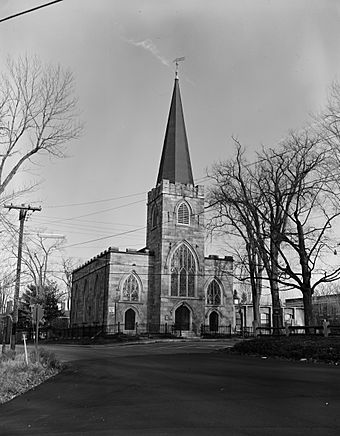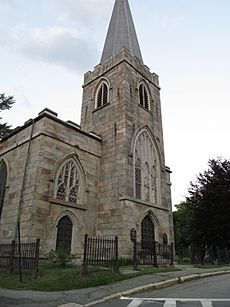Christ Episcopal Church (Gardiner, Maine) facts for kids
Quick facts for kids |
|
|
Christ Episcopal Church
|
|
 |
|
| Location | 2 Dresden Ave., Gardiner, Maine |
|---|---|
| Area | 1 acre (0.40 ha) |
| Built | 1820 |
| Architectural style | Gothic Revival |
| NRHP reference No. | 73000129 |
| Added to NRHP | July 24, 1973 |
Christ Episcopal Church is a historic church located at 1 Dresden Avenue in Gardiner, Maine. It was built in 1820 for the oldest church group in the Episcopal Diocese of Maine. This church is famous for being the oldest example of a special building style called Gothic Revival in all of New England. Because of its importance, it was added to the National Register of Historic Places in 1973.
A Unique Building Style
Christ Episcopal Church stands in the center of Gardiner, right next to the town common. It is a stone building with a tall, square tower in the front. The style of the church is called Gothic Revival, which was designed to look like the grand, old churches and castles of Europe from the Middle Ages.
What is Gothic Revival?
The Gothic Revival style was new to New England when this church was built. It uses special features to create a dramatic look:
- Pointed Arches: The doors and windows are set in arches that come to a sharp point at the top, called lancet arches.
- Towers and Spires: The church has a square tower with a pointed, eight-sided spire on top.
- Castle-Like Details: The top of the roof and the tower have a jagged, tooth-like pattern called crenellations, which look like the top of a castle wall.
The front of the church has three entrances, each with a pointed arch. Above them are windows with detailed patterns called tracery. The window in the center tower is the largest.
History of the Church
The Episcopal church group, or congregation, in Gardiner was started in 1772 by Sylvester Gardiner. He was an important landowner, and the city of Gardiner is named after him.
The building you see today is actually the third church built for this congregation. The first one burned down in 1792. The second one became too small for all the people who attended. So, in 1820, they built this new, larger church. It was designed by a minister named Samuel Farmer Jarvis, who chose the new "Gothick" style, as it was called back then. His design was the first of its kind in the region.
See also




